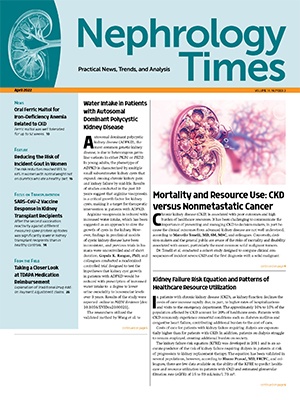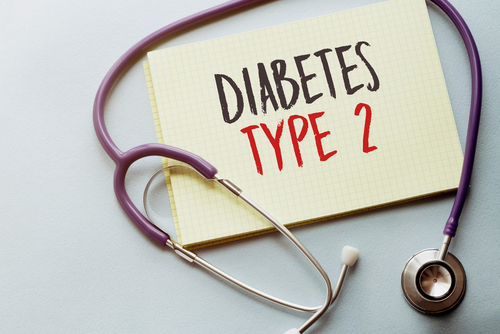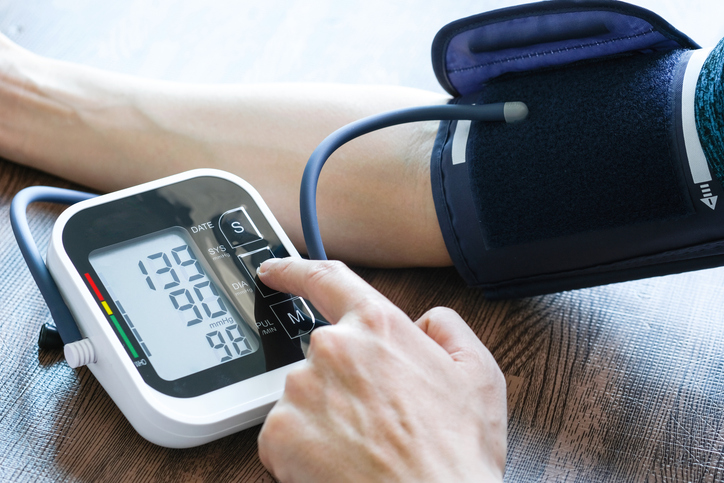
Patients receiving a solid organ transplant commonly develop post-transplant diabetes mellitus (DM), often within the first 2 to 3 years after transplant. Post-transplant DM occurs in 10% to 20% of nondiabetic kidney transplant recipients and is associated with premature cardiovascular disease, loss of graft, and mortality.
Risk factors for post-transplant DM include obesity, metabolic syndrome, cytomegalovirus infection, hepatitis C viremia, and calcineurin inhibitor (CNI) therapy. Older age has also been shown to be a strong and consistent risk factor for post-transplant DM among kidney transplant recipients and is associated with greater post-transplant morbidity. Median age at time of kidney transplant has been increasing worldwide, driven both by population aging and increasing acceptance of kidney transplant candidates >55 years of age for waitlisting and transplant. Previous studies have suggested that kidney transplant recipients have a 1.5-fold higher risk per decade of age of developing post-transplant DM.
One potentially modifiable risk factor for developing post-transplant DM is immunosuppression selection. Recommendations in 2014 suggested that immunosuppression regimens should fully optimize patient and allograft survival without concern for post-transplant DM. However, current guidelines recommend that tacrolimus and mycophenolate mofetil be used as first-line maintenance immunosuppression agents with appropriate induction medications.
Older kidney recipients often have a lower risk of acute rejection due to immunosenescence reducing the risk of rejection, and, potentially, the need for long-term triple therapy. Recent evidence suggests that lower-intensity immunosuppression regimens (e.g., steroid-sparing) may be beneficial in older kidney transplant recipients, reducing post-transplant death and graft loss. Further, obese patients have more than a 2-fold increase in the incidence of post-transplant DM compared with nonobese patients; however, they have an increased risk of rejection.
David A. Axelrod, MD, MBA, and colleagues conducted a retrospective database study designed to examine the impact of immunosuppression selection on the risk of post-transplant DM among both older and obese kidney transplant recipients. Results were reported in Kidney Medicine [2022;4(1):1-11].
The study participants were kidney-only transplant recipients ≥18 years of age from 2005 to 2016 in the United States, identified from the US Renal Data system records that integrate Organ Procurement and Transplantation Network/United Network for Organ Sharing records with Medicare billing claims. The study exposures were various immunosuppression regimens during the first 4 months following transplantation. The outcome of interest was development of DM >3 months to 1 years post-transplant.
Of the 193,984 kidney transplant recipients in the study period, 40,108 had Medicare coverage at the time of transplant and did not have pretransplant diabetes. There were differences between the study sample of Medicare beneficiaries without diabetes and the general transplant population in age, race, employment status, body mass index (BMI), and cause of end-stage kidney disease. Of the 40,108 individuals in the study sample, 38.0% were ≥55 years of age, 58.8% were men, 30.2% were African American, and 27.5% had a BMI of ≥30 kg/m2.
The most common immunosuppression regimen was tacrolimus + mycophenolic acid/azathioprine + prednisone), after T-cell-depleting induction: antithymocyte globulin (TMG) or alemtuzumab (ALEM) + triple therapy (47.2%), followed by TMG/ALEM + no prednisone (20.0%), triple maintenance after IL-2 receptor antibody (IL2rAb): IL2rAb + triple therapy (16.0%), CsA-based regimens (6.5%), and mammalian target of rapamycin inhibitor (mTORi)-based regimens (5.7%). IL2rAb + no prednisone (2.2%), and tacrolimus or tacrolimus + prednisone (2.2%%) with any induction (3.3%) were not commonly used.
Among older adults in the sample (≥55 years of age), the incidence of DM >3 months to 1 year after transplant was significantly higher than among those <55 years of age (16.7% vs 10.1%; P<.001). Among the older patients, the incidence of post-transplant DM within the first year varied more than 2.3-fold across regimens, from 11.6% among those on TMG/ALEM + no prednisone to 26.3% among those on mTORi-based regimens. Among younger patients, the incidence varied from 6.1% among those on IL2rAb + no prednisone to 20.2% among those on mTORi.
Following adjustment for potential confounding differences due to clinical characteristics, the risks of developing DM post-transplant remained significantly different across regimens. Among older recipients, the risk was decreased in recipients treated with TMG/ALEM + no prednisone (adjusted hazard ratio [aHR], 0.69; 95% CI, 0.60-0.79) or with IL2rAb + no prednisone (aHR, 0.76; 95% CI, 0.58-0.99); the risks were higher with mTORi-based therapy and CsA-based regimens than with TMG/ALEM + triple therapy. There was variation by age in the impact of mTORi immunosuppression on the risk of post-transplant DM.
Regardless of immunosuppression regimen, patients who were obese had significantly greater risk of post-transplant DM: BMI <30 kg/m2, 10.9%; BMI ≥30 kg/m2, 17.1%; P<.0001). The incidence of DM was highest among obese patients treated with mTORi-based regimens >3 months to 1-year post-transplant (32.4%); nonobese patients on tacrolimus or tacrolimus + prednisone had the lowest (7.1%). In patients with a BMI ≥30 kg/m2, the use of TMG/ALEM + no prednisone reduced the risk of post-transplant DM to 11.5%; 16% of patients on IL2rAb + no prednisone developed post-transplant DM.
Following adjustment for confounding, steroid avoidance with TMG/ALEM induction reduced the risk of post-transplant DM in obese patients (aHR, 0.67; 95% CI, 0.57-0.76). Steroid avoidances with IL2rAb induction resulted in a risk of post-transplant DM equivalent to that of obese patients managed with triple therapy (aHR, 0.99; 95% CI, 0.66-1.49).
Limitations to the study cited by the authors included the lack of data on levels of immunosuppression, including trough levels of CNIs and/or mTORi; other laboratory data were also not available. In addition, the choice of immunosuppression may have been affected by risk factors not captured in the database, and the possibility that post-transplant DM was under-reported when gathered from Medicare claims.
In summary, the researchers said, “Among Medicare-insured kidney transplant recipients, steroid-free immunosuppression is associated with a lower risk of post-transplant DM. This benefit was confirmed for high-risk patients (older adults; BMI ≥30 kg/m2); however, the importance of concomitant cell depleting differed. These data support the consideration of the risk of nonimmune complications along with the rejection risk when selecting immunosuppression regimens in kidney transplant recipients to minimize patient morbidity from immunosuppression-associated side effects.”
Takeaway Points
- In a retrospective database study, researchers examined the impact of immunosuppression selection on the development of post-transplant diabetes mellitus among older and obese kidney transplant recipients.
- Among patients ≥55 years of age, there were benefits of corticosteroid-sparing regimens with appropriate induction therapy on risk of DM post-transplant.
- There were also reductions in the risk of post-transplant DM with corticosteroid-sparing regimens with appropriate induction therapy among patients with body mass index of ≥30 kg/m2.







 © 2025 Mashup Media, LLC, a Formedics Property. All Rights Reserved.
© 2025 Mashup Media, LLC, a Formedics Property. All Rights Reserved.